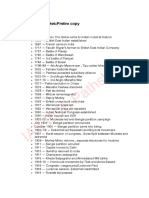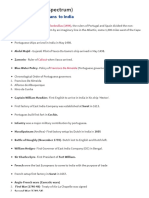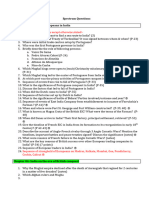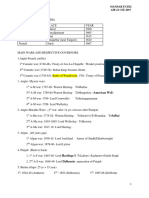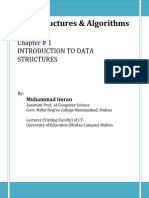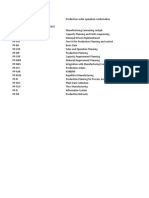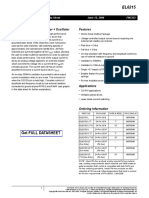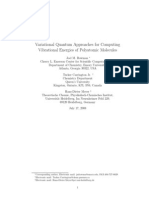Andhra Under Crown History
Uploaded by
Uday KumarAndhra Under Crown History
Uploaded by
Uday KumarMODERN ANDHRA
1. Advent of Europeans & Trade centres
2. Andhra under the Company
3. 1857 Revolt and its Impact on Andhra
4. Establishment of BriEsh Rule
5. Socio - Cultural Awakening
6. JusEce Party/Self Respect Movement
7. Growth of NaEonalist Movement in Andhra between 1885 to 1947
8. Role of Socialists - Communists - AnE-Zamindari and Kisan
Movements
9. Growth of NaEonalist Poetry & RevoluEonary Literature
10.Nataka Samasthalu
11.Women ParEcipaEon
• Samīkṣa’s App: h.ps://clplazarus.page.link/wKZ1
• Telegram: h.ps://t.me/samiksaacademy
• YouTube: h.ps://youtube.com/@thinksamiksa?si=PuzW7xB1qNLKVsxf
7337447348/9014185148 Samiksa’s AP History Material
INDEX
Topic Sub-Topic Page No.
• The Portuguese in India 1
• Arrival of the Dutch 2
• Arrival of the English 3
Advent of Europeans in
• Dutch in Andhra Pradesh 4
India and Andhra Pradesh
• English in Andhra 5
• French in Andhra Pradesh 6
• Portuguese in Andhra Pradesh 7
Andhra Under Company
• Dominance of BriLsh in Andhra 8
Rule
1857 Revolt and Its Impact • 1857 Revolt in Andhra and
27
on Andhra Rayalaseema
Establishment of Crown
• Andhra under the Crown 29
Rule
• Renaissance in Andhra Pradesh 38
• Pre-Veeresalingam Era 40
Socio-Cultural Awakening in
• Kandukuri Veeresalingam Era 42
Andhra Pradesh
• Social Reform Movement ATer
47
Kandukuri Veeresalingam
• JusLce Party 58
Self-Respect Movements in • Aadi Andhra Movement 61
Andhra • Phases of the Aadi Andhra Movement 63
• Dalit writers and literature 68
• Moderate Phase (1885–1905):
Growth of NaLonalism in Andhra
• Indian NaLonal Congress
• Vande Mataram Movement
Growth of NaHonal
• Swadeshi Movement in Andhra 81
Movement in Andhra
• Home Rule Movement in Andhra 84
(1885–1947)
• The Montague DeclaraLon of 1917 89
• Non-CooperaLon Movement in
91
Andhra
• Rampa Rebellion 104
7337447348/9014185148 Samīkṣa’s Modern Andhra Material
• Andhra Swarajya Party 107
• Simon Commission in Andhra 109
• Civil Disobedience Movement 114
• Salt Satyagraha in Andhra 116
• Round Table Conferences 126
• LeTist ParLes in Andhra Pradesh 127
• Cripps Mission 132
• The Quit India Movement 133
• Simla Conference 137
• Royal Indian Navy MuLny 139
• Mountbaben Plan 140
Role of Socialists & 141
Communists in Freedom • Communist Movement in Andhra 142
Struggle • Communist State Conferences 145
151
• AnL-Zamindari Movements 153
AnH-Zamindar & Kisan
• Peasant Movements in
Movements
Visakhapatnam and Srikakulam 165
District
Growth of NaHonalist
167
Poetry
RevoluHonary/Progressive
173
Literature
Nataka Samasthalu 175
Women ParHcipaHon in
185
Freedom Struggle
7337447348/9014185148 Samīkṣa’s Modern Andhra Material
7337447348/9014185148 Samīkṣa’s Modern Andhra Material
Andhra Under Company Rule
Dominance of Bri6sh in Andhra
Bri6sh control of Northern Circars
Though the French had gained control of the Northern Circars, they faced significant
opposiHon from local faujdars. For example, Jafar Ali, the Faujdar of Chicacole, revolted
against the French. The French had promised Vijaya Rama Raju, the king of Vijayanagar, the
revenue collecHon rights of Chicacole and Rajahmundry. Jafar Ali sought assistance from
the Marathas, but the Maratha forces were defeated at Gumapalam near Anakapalle.
Due to the growing unrest in the Northern Circars, Salabat Jung, the Nizam of Hyderabad,
issued a Farman to suppress French influence in the region. As a result, Bussy (the French
officer) occupied Goshamahal and Charm Mahal. Despite this, Salabat Jung conHnued to
support Bussy's power.
BaHle of Bobbili (1757)
The Ba/le of Bobbili (1757) was a crucial event. According to a play by Asupada
Krishnamurthy, Vijaya Rama Rajuof Vijayanagara killed the Bobbili Zamindar, Ranga Rao,
with the help of Bussy, and took control of Bobbili.
During the Third Carna*c War, a base was established at Rajahmundry by Conslav, a French
officer, who used it as a center for operaHons in Andhra.
Anand Gajapa* and Bri*sh Support
Anand Gajapa*, the son of Vijaya Rama Raju, grew disillusioned with the French and sought
help from the BriHsh. He invited Robert Clive to intervene, and Clive sent Colonel Ford to
meet with Anand Gajapa* and negoHate a treaty. The terms of the Kasim Kota
Treaty included:
• Equal division of plunder from conquered territories.
• Conquered territories were to be handed over to Vijayanagara Raju.
• Ports and towns in the conquered areas would be handed over to the East India
Company.
BaHle of Chandur6 (1759)
In 1759, Anand Gajapa* and Colonel Ford led the BriHsh forces to victory against the French
at the Ba/le of Chandur*. Colonel Mason, a BriHsh officer, noted that this ba_le was one of
the most brilliant victories, akin to the Ba/le of Plassey. Following this success, in 1759, the
BriHsh took control of Machilipatnam from the French.
7337447348/9014185148 Samīkṣa’s Modern Andhra Material Page 8
BaHle of Kandore (1760)
In 1760, Anand Gajapa* successfully occupied Samarlakota, Peddapuram, and Pithapuram,
further undermining French power in the region.
Shah Alam's Farman and Bri6sh Expansion
In 1765, Robert Clive persuaded Shah Alam (the Mughal Emperor) to issue a Farman, which
ceded the Northern Circars to the BriHsh. However, the Nizam rejected this order. The East
India Company then sent Jogi Pantulu, a Dubashi (interpreter), to negoHate with the Nizam's
government. As a result of these negoHaHons:
1. The Northern Circars came under BriHsh control for an annual lease of 13 lakh rupees.
2. The Guntur Sarkar was under the control of Salabat Jung, the Nizam's brother, and
in 1788, ager his death, the BriHsh fully took control of the Northern Circars.
BaHle of Padmanabha (1794)
In 1794, the Madras Government divided the Vijayanagara Zamindari into three
administraHve regions, diminishing the power and presHge of the Raja of Vijayanagara. The
Raja, feeling disempowered, decided to challenge the BriHsh. The Ba/le of Padmanabha was
fought between the Raja and the BriHsh, resulHng in the defeat and death of the Raja of
Vijayanagara.
Nizam Ali Khan of Hyderabad and Subsidiary Alliance
In 1798, Nizam Ali Khan entered into a Subsidiary Alliance with the BriHsh, agreeing to
maintain Bri*sh forces in his kingdom. As part of this alliance, the Nizam ceded the territories
of Kadapa, Kurnool, Anantapur, and Bellary to the BriHsh in 1800. Ager the Fourth Anglo-
Mysore War, BriHsh forces took control of Chi/oor and Nellore from the Carna*c Nawabs.
By 1801, through a series of military victories and poliHcal maneuvers, the BriHsh had secured
complete control over Andhra, marking the consolidaHon of BriHsh rule in the region.
Poligars resistance in Rayalaseema region
The resistance of the poligars in the Rayalaseema region against the BriHsh East India
Company is a notable chapter in India's early struggles against colonial dominaHon.
OriginaHng from the legacy of the Vijayanagara Empire, the poligars (or palegars) wielded
substanHal power as local chiegains, governing groups of villages with civil, military, judicial,
and execuHve authority. Their influence posed a significant challenge to the BriHsh ager the
region was ceded by the Nizam of Hyderabad.
Key Points of the Poligar Resistance:
1. Historical Background:
o The poligars' power was deeply entrenched in their control over local resources
and armed followers.
7337447348/9014185148 Samīkṣa’s Modern Andhra Material Page 9
o When Rayalaseema (Ceded Districts) was handed over to the BriHsh in 1800,
the poligars were stripped of their tradiHonal privileges, sparking widespread
discontent.
2. Role of Sir Thomas Munro:
o Appointed Principal Collector of the ceded districts (1800–1807), Munro took
decisive measures to subdue the rebellious poligars.
o Despite the Madras government’s reluctance to confront them, Munro issued
proclamaHons demanding the disarmament of the poligars and the payment
of peshkash (tribute).
o Ager iniHal resistance, many poligars were subdued, their estates confiscated,
and their influence curtailed.
3. Con*nued Resistance:
o Even ager Munro's efforts, unrest persisted, exemplified by Koilakuntla
Narasimha Reddy's (Uyyalavada Narasimha Reddy) revolt in Kurnool district
in 1846, which highlighted the lingering dissaHsfacHon with BriHsh rule.
o Captain Nolt ulHmately suppressed this revolt, symbolizing the eventual
military dominance of the BriHsh in the region.
4. Legacy of Munro:
o Following the suppression of the poligars, Munro implemented significant
administraHve reforms, including land surveys and the introducHon of
the Ryotwari System, which directly connected the government to individual
culHvators.
o His efforts to establish order and reform the revenue system earned him lasHng
respect in Andhra Pradesh, where he is venerated for his contribuHons.
5. Wider Implica*ons:
o The uprisings by poligars, along with revolts by rajas, zamindars, and tribal
groups across various regions (Bengal, Orissa, UP, Deccan), reflected
widespread discontent with BriHsh policies.
o These localized resistances set the stage for the larger and more organized
Revolt of 1857, ogen regarded as the first war of Indian independence.
The poligar uprisings underscore the complexity of early resistance to colonial rule and the
struggles faced by tradiHonal power structures in adjusHng to the new order imposed by the
BriHsh.
Administra6ve arrangements made by the Company
During the first half of the 19th century, the East India Company consolidated its posiHon in
Andhra by reorganizing the administraHon and establishing a system of districts under
collectors.
Administra6ve Reorganiza6on
1. Coastal Andhra (Northern Circars):
o Divided into five collectorates:
7337447348/9014185148 Samīkṣa’s Modern Andhra Material Page 10
1. Ganjam 4. Krishna
2. Visakhapatnam 5. Nellore
3. Godavari
o The administraHve system based on collectors began in 1794, replacing the
earlier Board of Revenue for Vizag and Machilipatnam, which was abolished
the same year.
2. Rayalaseema Region:
o 1800: The areas ceded by the Nizam were brought under a single collectorate
with Anantapur as the headquarters.
o Thomas Munro was appointed as the first collector on 24 October 1800.
o Sub-collectorates were established in:
1. Harpanahalli
2. Adoni
3. Cuddapah
4. Cumbum
o Subsequent divisions:
§ 1808: Bellary and Cuddapah made into separate districts.
§ 1858: Kurnool consHtuted as a separate district.
§ 1882: Anantapur consHtuted as a separate district.
§ 1911: Chi_oor consHtuted as a separate district.
Role of the Collector
• The collector was the linchpin of district administraHon, primarily responsible for land
revenue collecHon and holding judicial powers.
• In 1816, judicial powers were withdrawn from collectors, and special officers were
appointed for judiciary ma_ers.
• Most collectors were unfamiliar with the Telugu language and depended on corrupt
and inefficient local subordinates (dubashees).
• Thomas Munro was a notable excepHon; he spoke Telugu fluently and managed the
administraHon effecHvely without intermediaries.
Revenue Systems in Coastal Andhra Before the Permanent SeHlement
The coastal Andhra zamindari areas employed three main revenue systems:
1. Asra System:
o The government claimed half of the gross produce.
o Assessment was conducted either by esHmaHon or measurement, ogen
leading to inaccuracies.
o Revenue was collected in cash or kind.
2. Veesabadi System:
o Village lands were distributed among chief ryots (farmers) by shares.
o Periodic redistribuHon ensured joint responsibility for tax assessment.
o Se_lements were made with individual ryots, and assessments were fixed.
7337447348/9014185148 Samīkṣa’s Modern Andhra Material Page 11
3. Ren*ng System:
o Villages or enHre parganas were farmed out to public revenue collectors.
o DocumentaHon on collecHons from culHvators is limited.
Issues in Revenue Collec*on
• Pe/andars (leading ryots) and karnams (village accountants) wielded significant
power, ogen allocaHng ferHle lands to themselves.
• Richer ryots paid revenue easily, while poorer ryots faced heavy assessments on
inferior lands, leading to arrears.
Government Lands (Havelis)
• Havelis: Lands directly held by the government for provisioning garrisons, expanded
by acquiring properHes from rebellious zamindars.
• Revenue Collec*on Methods:
1. Aumani: Government agents directly managed revenue collecHon.
2. Leasing: Lands were leased for a sHpulated rent.
This structured administraHve and revenue system laid the foundaHon for the Company's
control over Andhra, despite challenges like corrupHon, inefficiency, and exploitaHon.
Land Revenue System Under Company Rule
The East India Company implemented various land revenue systems in Andhra Pradesh to
maximize revenue collecHon, each with disHnct features and impacts:
Auc6on System
• Process:
o Revenue collecHon rights were awarded to the highest bidder.
o The successful bidder collected revenue from ryots (farmers) and paid a fixed
amount to the BriHsh government.
• Region:
o Predominantly used in the Rayalaseema region.
• Drawbacks:
o Led to exploitaHon and corrupHon as bidders prioriHzed profits.
o The Sircute Commi/ee recommended abolishing this system.
Zamindari System
• Key Features:
o Introduced in the Northern Circars region.
o Two types of land under this system:
1. Haveli Lands: Lands under direct government control.
2. Zamindari Lands: Private estates with a revenue rate of 1/5.
o Zamindars acted as intermediaries between the BriHsh and the ryots, with no
direct connecHon between ryots and the government.
7337447348/9014185148 Samīkṣa’s Modern Andhra Material Page 12
oZamindars were responsible for paying a lump sum to the BriHsh
called Peshkash and collected revenue from ryots to meet this obligaHon.
• Drawbacks:
o Zamindars ogen exploited ryots to meet their dues, leading to economic
distress for farmers.
Gramvari System
• Key Features:
o Revenue collecHon authority was vested in village officers.
o Village officers collected revenue from ryots and paid it directly to the
government.
o There was no direct connecHon between the ryots and the government.
• Implementa*on:
o First introduced in Nellore district and later extended to other districts
in Rayalaseema and the Sarkar (Northern Circars) districts.
• Evolu*on:
o Replaced by the Permanent Se/lement System.
Ryotwari System
• Introduc*on:
o Developed by Thomas Munro in 1807 and implemented in all Rayalaseema
districts.
o Based on the principles laid down by Reed (Salem Collector) and modified
by Munro to suit regional needs.
• Key Features:
o Land was measured and surveyed to assess its ferHlity.
o Tax was determined based on the ferHlity and producHvity of the soil.
o Direct relaHonship established between the ryot and the government.
o Ryots paid revenue directly to the government, eliminaHng intermediaries like
zamindars or village officers.
• Types of Land:
o Haveli Lands: Governed by the Ryotwari system.
o Zamindari Lands: ConHnued under the Zamindari system.
Comparison of Systems
Connec*on
System Region Key Collector Drawbacks
with Ryots
AucHon Rayalaseema - Indirect ExploitaHon and
corrupHon
7337447348/9014185148 Samīkṣa’s Modern Andhra Material Page 13
Zamindari Northern Circars - Indirect Zamindar exploitaHon,
lack of reforms
Gramvari Nellore, Sarkar - Indirect Inefficient and replaced
areas by Permanent
Se_lement
Ryotwari Rayalaseema, Thomas Direct Labor-intensive, relied
Haveli lands Munro on accurate surveys
(1807)
The Ryotwari System, despite its challenges, became the foundaHon for modern land revenue
policies by establishing a direct relaHonship between farmers and the government.
Judicial System Under Company Rule
The East India Company introduced significant changes to the judicial system in India to
establish control and cater to its administraHve needs.
Key Changes in the Judicial System
1. Mayor’s Court (1726):
o Established in Madras (present-day Chennai).
o FuncHon: Handled cases involving Europeans and their interacHons with
Indians.
o Legal Basis: Operated under English common law.
2. Dual Courts (1772):
o Introduced under the Regula*ng Act of 1772.
o Two parallel systems:
§ Diwani Adalat:
§ Presided over by BriHsh collectors.
§ Dealt with civil disputes like revenue and land ma_ers.
§ Decisions were based on a mix of local customs and
interpretaHons of Hindu and Muslim laws.
§ Fauzdari Adalat:
§ Managed by Indian judges under BriHsh supervision.
§ Handled criminal cases, applying Islamic law (Sharia).
3. State-Level Courts:
o Sadar Diwani Adalat:
§ Dealt with civil cases at the appellate level.
o Sadar Fauzdari Adalat:
§ Dealt with criminal cases at the appellate level.
4. District-Level Judiciary:
o District Judge:
§ Head of judicial administraHon at the district level.
7337447348/9014185148 Samīkṣa’s Modern Andhra Material Page 14
o Sadar Ameen:
§ Dealt with pe/y cases and funcHoned under the district judge.
Challenges and Inefficiencies
• Corrup*on and Inefficiency:
o Judicial departments were plagued with corrupHon and inefficiency.
o Judges were ogen ill-qualified and lacked proper legal training.
• Incompetent Appointments:
o Officials deemed unsuitable for the revenue department were ogen
transferred to the law department and appointed as judges.
o Many such individuals had limited understanding of judicial procedures and
local laws.
• Cri*cism:
o Gajula Narasimha Che/y, a member of the Madras Na*ve Associa*on,
criHcized the judicial service of the Company, calling it a "refuge of the
des*tute" due to the incompetence of judges.
Addi*onal Points
• The judicial structure under the Company reflected a mix of BriHsh legal principles and
local customary laws, ogen leading to inconsistencies.
• The dual system of courts aimed to balance local laws with colonial governance but
largely served the interests of the Company.
• Judicial reforms, though introduced, ogen failed due to inadequate implementaHon
and the lack of qualified personnel.
This system laid the groundwork for subsequent judicial reforms during the BriHsh Raj.
Religious Condi6on Under Company Rule
The East India Company’s rule saw the increasing influence of ChrisHan missionaries, who
aimed to propagate ChrisHanity alongside introducing Western educaHon. Their efforts
significantly impacted the cultural and social landscape of Andhra Pradesh.
Role of Missionaries and Their Ini*a*ves
1. Introduc*on of Western Educa*on:
o Missionaries believed that English educa*on would help naHves adopt
ChrisHanity.
o Charles Grant emphasized that the primary aim of English educaHon was to
impart knowledge about ChrisHanity.
2. Portuguese Jesuit Presence:
o Portuguese Jesuit fathers were acHve in the court of Venkatapathi Rayalu
II (1797).
7337447348/9014185148 Samīkṣa’s Modern Andhra Material Page 15
3. Protestant Centers:
o Prominent centers included Punganur and Firangipuram (Guntur).
4. Dutch Missionary Contribu*ons:
o Tharangambadi (Tamil Nadu) served as a key center for propagaHng
ChrisHanity.
o Benjamin Schultze (1689–1760):
§ A German Lutheran missionary, he made significant contribuHons to
Telugu and ChrisHanity.
§ Authored the first printed Telugu grammar book (1728).
§ Translated the Bible into Telugu (1728–1732) using Luther’s German
Bible and original Greek and Hebrew texts.
§ Converted 96 individuals in Madras between April 1728 and June 1729,
known as the "Malabarians converted by Mr. Schultze."
5. Bible Transla*on and Missionary Ac*vi*es (1807–1810):
o Subbarayudu, a Telugu Brahmin, helped translate the Bible and adopted
ChrisHanity, taking the name Anandarayudu.
o Anandarayudu established a missionary center in Visakhapatnam and
authored Vedanta Rasayanam.
o The first Bible printed in Telugu was completed under Dutch missionaries.
Expansion of Chris*an Missionary Work
1. London Missionary Society:
o Established a mission in Visakhapatnam, which expanded to Cuddapah by
1922.
2. Educa*onal Ins*tu*ons:
o Reverend Noble School (Church Missionary School) in Machilipatnam (1843)
was one of the first educaHonal insHtuHons, founded by the Church Missionary
Society.
3. Spread Through the 1813 Charter Act:
o The Charter Act of 1813 allowed ChrisHan missionaries to freely propagate
their religion and establish educaHonal insHtuHons.
Major Chris*an Missions in Andhra Pradesh
1. Lutheran Mission: Guntur.
2. Church Missionary Society: Hyderabad.
3. Canadian Bap*st Mission: Ongole.
The acHve role of missionaries significantly influenced the region’s socio-cultural fabric,
parHcularly through educaHon and religious conversions. Their work in language translaHon,
educaHon, and infrastructure had a lasHng impact on Andhra society.
7337447348/9014185148 Samīkṣa’s Modern Andhra Material Page 16
Agriculture Under Company Rule
During the rule of the East India Company, the agricultural sector in Andhra Pradesh faced
significant neglect, parHcularly in the domain of irrigaHon and famine management. The
limited iniHaHves undertaken were concentrated in select regions, leaving large areas
vulnerable to crises.
State of Irriga*on
1. General State of Irriga*on:
o The Company showed li_le concern for maintaining tanks and canals, which
were vital for tradiHonal irrigaHon.
o Most of the irrigaHon infrastructure fell into disrepair.
2. Limited Irriga*on Works:
o Godavari River (1847–1852):
§ Sir Arthur Co/on oversaw the construcHon of an anicut
near Dowleswaram to improve irrigaHon in the Godavari delta.
o Krishna River (1850–1855):
§ With assistance from Captain Orr, an anicut was constructed
near Vijayawada, benefiHng the Krishna delta.
o These projects brought prosperity to the delta regions of the Godavari and
Krishna rivers.
o However, other regions of Andhra Pradesh were leg without significant
irrigaHon projects.
Impact of Famine
1. Frequent Famines:
o Andhra Pradesh suffered recurrent famines due to neglect of agriculture and
irrigaHon:
§ 1791: Ganjam famine.
§ 1805–1807: Severe famine across Andhra, causing depopulaHon in
many villages.
§ 1811: Famine struck Nellore district.
§ 1823: Large areas were affected.
§ 1833: Known as the "Dokkala Karuvu", this famine in Guntur
claimed 40% of the popula*on.
§ 1839: Another severe famine devastated the region.
2. Government Apathy:
o The Company failed to provide adequate relief during these famines,
exacerbaHng their impact.
7337447348/9014185148 Samīkṣa’s Modern Andhra Material Page 17
Limited Agricultural Support
1. Anicuts and Their Impact:
o The anicuts on the Godavari and Krishna rivers facilitated irrigaHon and
economic growth in their respecHve delta regions.
o Outside these areas, agriculture remained vulnerable, leading to frequent crop
failures.
2. Inequality in Development:
o While the delta regions saw some prosperity due to improved irrigaHon,
the rest of Andhra conHnued to face neglect and hardship.
The Company’s approach to agriculture in Andhra Pradesh highlighted a lack of
comprehensive planning and disregard for the needs of the majority. While selecHve irrigaHon
projects improved specific regions, most of Andhra Pradesh suffered from inadequate
infrastructure, frequent famines, and government inacHon.
Handicra[s Under Company Rule
During the East India Company’s rule, handicrags, a vital source of livelihood for non-
agricultural classes, suffered a significant decline. This period marked the erosion of tradiHonal
industries and the disempowerment of arHsan communiHes.
Tex6le Industry
1. Ager agriculture, tex*le produc*on was the main occupaHon, conducted within
households.
o Even women observing 'Gosha' (purdah) contributed to the industry by
working at home.
2. Weavers in Rayalaseema ogen pracHced polygamy to increase household income,
with all family members contribuHng financially.
3. Despite collecHve efforts, many weavers remained impoverished due to extravagant
lifestyles involving drinking, gambling, and cockfigh*ng.
4. Andhra Pradesh was famous for its texHles, such as:
§ Silks of Berhampur.
§ Muslins of Srikakulam.
§ Chintzes of Machilipatnam.
§ Rumals of Nellore.
5. Decline of the Industry:
o The industry faced challenges due to compeHHon from low-priced, machine-
made fabrics from England.
o The Company’s policies, such as excessive transit duHes and the Moturpha
tax on looms, further devastated the local industry.
o The export hubs of Visakhapatnam, Machilipatnam, and Nellore saw a drasHc
decline in trade.
7337447348/9014185148 Samīkṣa’s Modern Andhra Material Page 18
6. Impact on Weavers:
o Many weavers migrated to Sri Lanka, Burma, and Mauri*us to seek be_er
opportuniHes.
o By the mid-19th century, silk fabric exports declined due to compeHHon
from Chinese and Japanese silk.
7. Prominent Tex*les and Loca*ons:
o Berhampur: Silks.
o Machilipatnam: Dyed cloth (Addakam Vastralu).
o Peddapuram, Dharmavaram, Adoni, Bellary: Silk (Pa/u Vastralu).
o Nellore: Handkerchiefs (Rumals).
o Tuni: DhoHs (Dhovathi).
o Kurnool: Bedsheets (Duppa*).
o Srikakulam: Muslin.
o Eluru: Tiwachi.
o Srikalahas*: Kalamkari.
Carpet Making in Andhra Pradesh
Carpet making was one of the notable industries in Andhra Pradesh during the Company's
rule. It flourished in Eluru and Kurnool but faced significant challenges over Hme.
1. Eluru Carpets:
o Carpet-making in Eluru was introduced by Persian immigrants and
gained interna*onal recogni*on, notably at the London Exhibi*on of 1851.
o Carpets were craged using indigenous wool sourced from the Krishna and
Godavari districts.
o Popular designs included Farishkhani and Ashunkhani moHfs, reflecHng
intricate arHstry.
2. Carpet Making in Rayalaseema:
o Carpet producHon extended to Adoni and Bellary, primarily serving local
markets.
o However, these carpets were not as highly valued as those produced in Eluru
or Machilipatnam, which was another significant carpet-making center.
3. Decline of the Industry:
o By the mid-19th century, the carpet industry experienced a sharp decline.
o This was not due to a lack of weavers’ skills but rather the absence
of government and popular support for the industry.
4. Impact on Other Ar*s*c Industries:
o The decline of carpet making was reflecHve of a broader trend, with ar*s*c
industries and even the ship-building industry (along the coast from Ganjam
to Nellore) facing similar fates.
The neglect of tradiHonal industries during the Company's rule leg a lasHng impact on Andhra
Pradesh's cultural and economic heritage, causing the decline of once-thriving local crags.
7337447348/9014185148 Samīkṣa’s Modern Andhra Material Page 19
Educa6on Under Company Rule in Andhra Pradesh
EducaHon in Andhra Pradesh during the Company's rule was largely neglected, with limited
funding and inadequate iniHaHves for higher educaHon.
1. Funding for Educa*on:
o In 1813, the Company allocated one lakh rupees for educaHon across India,
but this funding had a negligible impact on the development of educaHon in
Andhra Pradesh.
2. Proposed Educa*onal Reforms:
o Governor Thomas Munro proposed the establishment of 40 collectorate
schools and 300 tahsildari schools to improve educaHon.
o However, this ambiHous plan failed by 1839, reflecHng the lack of systemaHc
support and implementaHon.
3. Government-Backed Ins*tu*ons:
o The Central Collegiate Ins*tu*on, founded in Madras in 1841, was one of the
few government-supported educaHonal efforts.
o This insHtuHon relied on a combinaHon of dona*ons and student fees.
o However, most of the Presidency, including Andhra Pradesh, remained
neglected in terms of educaHonal development.
4. Role of Missionary Schools:
o Missionary schools focused more on prosely*zing and converHng students
to Chris*anity than on providing a well-rounded educaHon.
o These schools were ogen supported by the government, leading to a bias
toward Chris*an converts in societal and judicial ma_ers.
5. Discrimina*on Against Hindus:
o The government's support of missionary schools
fostered discrimina*on against Hindus, both socially and judicially, further
alienaHng naHve communiHes from the educaHonal benefits of the period.
The neglect of educaHonal infrastructure and the focus on religious conversions hindered the
development of a robust and inclusive educaHonal system during the Company's rule.
Literature During Company Rule:
Author Work(s)
Mamidi Venkayya(1806) Andhra Deepika (Dictionary)
Kankati Paparaju Uttara Ramayanam
Kuchamanchi Timma Kavi Achcha Telugu Ramayanam, Kukteshwar Satakam,
Kavilasundara Parinayam
Pindiprolu Lakshmana Kavi Ravana Dhamiyam
Gogula Koramanatha Kavi Narasimha Satakam
Betapudi Sundarayudu Nilgiri Yatra Charitra
Bhallala Peraiah Bhadragiri Satakam
7337447348/9014185148 Samīkṣa’s Modern Andhra Material Page 20
Nimmana Lakshmana Kavi Eka Andhra Linga Satakam
Aiyyala Raju Narayana Hamsavimsathi
Mathyudu
Kasturi Ranga Kavi Ananda Rathbandhanam
Ditta Kavi Narayana Kavi Rangaraya Charitra
Puduru Sita Rama Sastri Pedda Bala Shiksha
Prominent Personali6es:
George Noble Taylor was a prominent figure in 19th-century Andhra Pradesh. He served as
the Sub-Collector of Rajahmundry Division and made significant contribuHons to educaHon in
the region.
In 1852, Taylor established the Taylor High School in Narsapur, one of the earliest schools in
the area. This insHtuHon played a key role in providing educaHon and shaping the future of
many students in the region.
Taylor also helped establish several Anglo-Vernacular schools in towns such
as Palakol, Penugonda, and Achanta, which greatly improved access to educaHon for the local
populaHon.
The Wood's Dispatch of 1854, also known as the Magna Carta of Indian Educa*on, had a
profound impact on the development of educaHon in India. This policy, introduced by
Sir Charles Wood, the then President of the Board of Control of the East India Company, led
to reforms that benefited schools like the one in Rajahmundry.
Sir Thomas Munro:
Sir Thomas Munro was one of the most respected officials of the East India Company in
Andhra Pradesh, alongside Sir Arthur Cotton and Charles Philip Brown.
• Early Life and Career:
o Born in Glasgow in 1761, Munro joined the East India Company as a military
cadet and arrived in Madras in 1780.
o His career in India can be divided into four periods:
1. 1780-1792: Served in the army, participating in the wars against Haider
Ali and Tipu Sultan of Mysore.
2. 1792-1807: Worked in civil administration, serving in regions such as
Bara Mahal (Salem), Kanara district, and as Principal Collector of the
ceded districts acquired from the Nizam of Hyderabad.
3. 1814-1818: Returned to India and served as the President of the
Judicial Commission.
4. 1820-1827: Served as the Governor of Madras until his death in Kurnool
district on 6th July 1827.
7337447348/9014185148 Samīkṣa’s Modern Andhra Material Page 21
• Reforms and Contributions:
o Munro's tenure as Governor focused on administrative reforms and the
development of educational and irrigation systems.
o He emphasized the importance of using local languages, including Telugu, in
administration and education.
o Munro played a significant role in shaping Andhra Pradesh's socio-political
landscape during British rule.
Munro as the Collector of Bara Mahal and the Ryotwari System:
1. Introduction of the Ryotwari System:
o In 1792, Tipu Sultan ceded territories, including Bara Mahal (modern Salem,
Dharmapuri, and part of Madurai districts), to the East India Company after
the Third Mysore War.
o Lord Cornwallis appointed Captain Read as Superintendent of Revenue, and
Munro served as one of his assistants to oversee Bara Mahal's civil
administration.
o Munro introduced the Ryotwari system of revenue collection during his
tenure in Bara Mahal (1792-1799), which allowed direct collection of land
revenue from farmers by Company officials.
o The system granted farmers land ownership rights, enabling them to sublet,
sell, or mortgage their property. Farmers could not be evicted as long as they
paid the fixed assessment.
2. Impact of the Ryotwari System:
o The system proved beneficial to both farmers and the Company, and it became
a model for other regions.
o Munro's policies aimed to improve the welfare of the ryots, providing
necessary resources like seeds, tools, and infrastructure before cultivation.
o In times of drought, famine, and heavy rains, Munro responded quickly by
repairing tanks and channels, which helped in increasing crop yields and
achieving 100% revenue collection.
3. Problems with the Ryotwari System:
o The land revenue was estimated for 10 years based on patta (land records).
o High tax rates (around 50%) negatively impacted farmers, especially when
prices dropped. Tax payments were made in cash, making farmers vulnerable
to market fluctuations.
o Munro's Report (1802): Munro submitted a report to the government
requesting the reduction of land revenue during times of floods and drought,
suggesting an 8% reduction for irrigated lands and 25% for unirrigated lands.
He also proposed providing loans to farmers affected by the system.
7337447348/9014185148 Samīkṣa’s Modern Andhra Material Page 22
Munro as President of the Judicial Commission:
In 1814, Sir Thomas Munro returned to India for his second tenure as the head of the Judicial
Commission. His primary task was to examine the administration of justice and police in the
Presidencies of Bengal and Madras and propose measures for their improvement.
• Key Recommendations:
o Transfer of police supervision: Munro suggested transferring police
supervision from the judges to the collectors, which streamlined the
administrative structure and improved law enforcement efficiency.
o Appointment of village officials: He recommended appointing village officials
to handle petty crimes and maintain local order.
o Enhancement of judicial processes: Munro proposed simplifying and
expediting the justice system by improving court proceedings and ensuring the
appointment of competent judicial officers.
Final Years and Legacy:
• Munro returned to India for the third and final time in 1820 when he was appointed
Governor of Madras. He continued to implement reforms, particularly in education
and infrastructure.
• Tragically, in 1827, while on a tour of the Kurnool district, Munro contracted cholera
and passed away on July 6th.
• Munro is fondly remembered as a "Mandava Rishi," and his legacy lives on, with many
parents naming their children "Munrolappa" in his honor.
C.P. Brown (Charles Philip Brown):
C.P. Brown, often praised by Telugu poets as a figure akin
to Krishnadevaraya and Raghunathanayaka, made significant contributions to Telugu
literature and culture.
• Early Life and Education:
o Born on November 10, 1798, in Calcutta, Brown was the son of Rev. David
Brown, who was the Senior Chaplain of the East India Company in Bengal.
o He joined Fort St. George College in Madras, where he
studied Telugu and Marathi, and graduated in June 1820.
• Career and Contributions:
o Brown was initially appointed as Second Assistant to the Principal
Collector of Cuddapah in August 1820. During this time, he began learning
Telugu under the guidance of Velagapudi Kodanda Ramayya.
o Paityam Parabrahma Shastri also played a crucial role in helping Brown
understand and engage with Telugu kavyas (poetry).
7337447348/9014185148 Samīkṣa’s Modern Andhra Material Page 23
o Brown had about 20 Pandits in his payroll, who were tasked with transcribing
native authors, preparing correct editions, and framing indices and
commentaries. Key members of this group included:
1. Paityam Parabrahma Shastri
2. Juloory Appaiya
3. Ravi Paty Gurumurthy Shastri
o He contributed 5751 manuscripts to the Government Oriental Manuscript
Library in Madras, helping preserve invaluable Telugu texts.
• Publications and Works:
o In 1827, Brown published several works, including:
§ A Dictionary of Telugu and English
§ A Grammar of the Telugu Language
§ A Dictionary of the Mixed Dialects and Foreign Words Used in Telugu
§ Andhra Geervana Chandamu (Prosody of Telugu and Sanskrit)
o He also worked on the Lokam Cheta Vrayabadina Subha Vartamanamu, a
translation of Bible stories into Telugu.
o Some of Brown's most notable historical contributions include the translation
of The Wars of the Rajas or Rajula Yuddhamulu, which is the history of
Anantapur, written in Telugu during the period of 1750–1810, and translated
into English in 1853.
o In 1840, Brown published A Grammar Book of Telugu, followed by the Telugu-
to-English and English-to-Telugu Dictionaries in 1852 and 1854, respectively.
o He also worked on the Vemana Satakam and contributed to other important
works like Yenugula Veera Swamy Yatra Charitra and Kashi Yatra.
• Later Life and Death:
o Brown resigned from service in 1855 and returned to London. He passed away
as an Octogenarian on December 12, 1884.
• Legacy:
o To perpetuate the memory of C.P. Brown, a library building was constructed
at Cuddapah, on the site of his bungalow, which was known as Brown’s
Works. This library continues to serve as a tribute to his contributions to
Telugu literature and culture.
Colin Mackenzie:
• Colin Mackenzie was born in 1754 in Stornoway, Scotland, into a prominent family.
He iniHally worked as a Comptroller of Customs before securing a commission in
the East India Company's army in 1783.
• Military Service and Mapping Work:
7337447348/9014185148 Samīkṣa’s Modern Andhra Material Page 24
o Mackenzie served as a military engineer during the Third Anglo-Mysore
War against Tipu Sultan and gained recogniHon for his strategic sketches of
the ba_lefield.
o He later became a Major and then a Colonel, working on various assignments,
including surveying and mapping the Nizam's dominions in Hyderabad.
• Assistants and Collabora*ons:
o Mackenzie relied on the assistance of talented interpreters, including Kavali
Venkata Burriah and Kavali Lakshmaiah, who were instrumental in helping
him access and understand Indian knowledge.
o Another notable assistant was Melur Dharmaiah, an expert in reading
ancient Kannada texts, who supported Mackenzie's research.
• Contribu*ons to Indian Heritage:
o Mackenzie played a crucial role in bringing a_enHon to the rich architectural
heritage of the Vijayanagara ruins at Hampi. He visited the site in 1799 and
created watercolor painHngs of the monuments, preserving them for future
generaHons.
o He also documented his findings at other significant sites such
as Amarava* and Mahabalipuram, with his works now housed in insHtuHons
like the Bri*sh Museum and Bri*sh Library.
o Mackenzie is also credited with precise measurements of the Gomateswara
statue at Sravanabelagola.
• Aoer Mackenzie's Death (1821):
o Following Colin Mackenzie's death in 1821, his assistant Kavali
Lakshmaiah stayed in Calcu/a for two years.
o Lakshmaiah's purpose was to assist H.H. Wilson, an Orientalist, in cataloging
Mackenzie's extensive collecHons of manuscripts, drawings, and other
materials.
o Lakshmaiah played a crucial role in organizing and preserving the knowledge
and historical records that Mackenzie had gathered during his Hme in India.
• Mackenzie's Work at Amarava*:
o Mackenzie’s vast collec*on of illustra*ons includes 85 sketches made at
the Amarava* site, an ancient Buddhist site in Andhra Pradesh, India.
7337447348/9014185148 Samīkṣa’s Modern Andhra Material Page 25
o Mackenzie visited Amarava* in 1798 and conducted more systemaHc studies
between 1816 and 1820, ager becoming Surveyor General. Three copies of his
documents were made, with only the London copysurviving today.
o John Newman, Mackenzie's dragsman from 1810-1818, created addiHonal
sketches of the site.
o Mackenzie discovered around 132 stones at AmaravaH, but these are no longer
traceable. He iniHally believed the site was related to the Jain religion, as he
had no knowledge of Buddhism in India at the Hme.
• Amarava* Stones:
o The stones from Amarava* were transported to Masulipatam, with some
deposited into "Robertson's Mound" (named ager Robertson, the Assistant
Collector of Masulipatam in 1814). Most of these stones were later moved to
the Madras Museum along with Sir Walter Elliot’s collec*ons from AmaravaH.
o Approximately 79 stones depicted in Mackenzie’s drawings remain
unaccounted for and cannot be traced to museum collecHons.
Robert Caldwell
• A Comparative Grammar of the Dravidian or South-Indian Family of
Languages (research on the Telugu language)
J N Boyel
• Famous for Telugu Ballad Poetry (Janapadham)
• Indian Antiquity Book (in which six Telugu Janapada Geyas are mentioned; Sarvai
Papannakatha is one of those ballads, with the remaining five being Srungara Geyas).
G.N. Taylor (Rajahmundry Sub-Collector)
• Vernacular Schools in Godavari District: These schools are known as Taylor Schools.
The first Anglo-Vernacular School was established in Narsapur.
Yuri Davis
• Schools in Cuddapah: Focused on education in the Cuddapah district.
7337447348/9014185148 Samīkṣa’s Modern Andhra Material Page 26
You might also like
- History of Modern Andhra INDIAN CULTURENo ratings yetHistory of Modern Andhra INDIAN CULTURE156 pages
- 2'Nd Year, 4'Th Sem History of Andhra Material (Final Project)No ratings yet2'Nd Year, 4'Th Sem History of Andhra Material (Final Project)82 pages
- Andhra's Role in India's Freedom MovementNo ratings yetAndhra's Role in India's Freedom Movement28 pages
- Sankalp: Section B - History and Culture of AndhraNo ratings yetSankalp: Section B - History and Culture of Andhra10 pages
- Step by Step Chronology For Modern HistoryNo ratings yetStep by Step Chronology For Modern History3 pages
- 3 - Provincial Kingdoms and British ExpansionNo ratings yet3 - Provincial Kingdoms and British Expansion61 pages
- 3 Modern History Complete English NotesNo ratings yet3 Modern History Complete English Notes53 pages
- Agm Higher Secondary School: UNIT - 6 Early Revolts Against British Rule in Tamil NaduNo ratings yetAgm Higher Secondary School: UNIT - 6 Early Revolts Against British Rule in Tamil Nadu31 pages
- British & Southern India: The Carnatic Wars & Anglo-Mysore WarsNo ratings yetBritish & Southern India: The Carnatic Wars & Anglo-Mysore Wars19 pages
- Regional Kingdoms and Expansion of British Rule in India-INo ratings yetRegional Kingdoms and Expansion of British Rule in India-I51 pages
- Modern History Complete English Notes PDFNo ratings yetModern History Complete English Notes PDF52 pages
- Study Material IBM Placement Interview Questions 07122023No ratings yetStudy Material IBM Placement Interview Questions 0712202332 pages
- Andhra Pradesh Socio-Economic Survey 2023-24100% (2)Andhra Pradesh Socio-Economic Survey 2023-24421 pages
- 01 Financial Management (4 Files Merged)No ratings yet01 Financial Management (4 Files Merged)51 pages
- IS208 PROFESSIONAL ISSUES IN INFORMATION SYSTEMS Revised67% (3)IS208 PROFESSIONAL ISSUES IN INFORMATION SYSTEMS Revised2 pages
- Minimalism For Living, Family & Budgeting (PDFDrive)100% (1)Minimalism For Living, Family & Budgeting (PDFDrive)154 pages
- 3-Channel Laser Diode Driver + Oscillator Features: Get Full DatasheetNo ratings yet3-Channel Laser Diode Driver + Oscillator Features: Get Full Datasheet2 pages
- Biology Form 5 Chapter 2 Subtopic 2.3 Main Organ For TranspirationNo ratings yetBiology Form 5 Chapter 2 Subtopic 2.3 Main Organ For Transpiration16 pages
- Serrano v. Central Bank of The PhilippinesNo ratings yetSerrano v. Central Bank of The Philippines2 pages
- Living Conditions During The Industrial RevolutionNo ratings yetLiving Conditions During The Industrial Revolution7 pages
- WWG - Maiden of The High Seas - Props - InstructionsNo ratings yetWWG - Maiden of The High Seas - Props - Instructions22 pages
- MANM519 - Week 3 AI Jobs and Future of Work - Lecture NotesNo ratings yetMANM519 - Week 3 AI Jobs and Future of Work - Lecture Notes12 pages
- Joel M. Bowman Et Al - Variational Quantum Approaches For Computing Vibrational Energies of Polyatomic MoleculesNo ratings yetJoel M. Bowman Et Al - Variational Quantum Approaches For Computing Vibrational Energies of Polyatomic Molecules73 pages
- Comments/Remarks:: Name: Tupas, Re CharlesNo ratings yetComments/Remarks:: Name: Tupas, Re Charles3 pages










